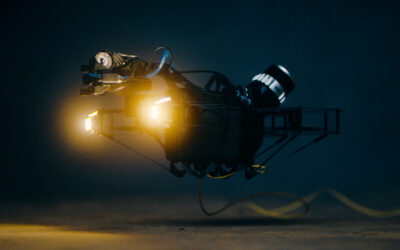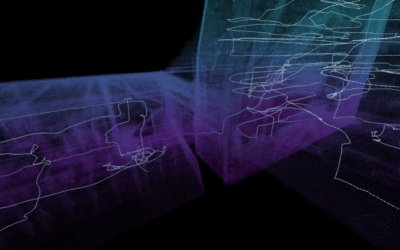Efficient and Safe FPSO Cargo Tank Inspections: Discover how the Scout 137 Drone System enabled BVLOS operations with no human entry, delivering superior results in record time.
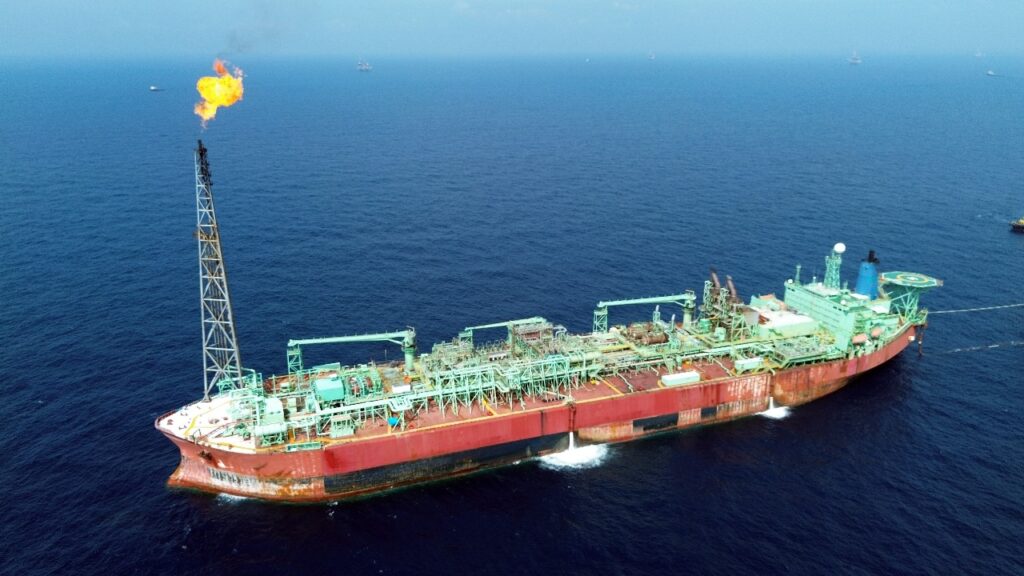
This Cargo Tank inspection was performed while the FPSO was moored in the Gulf of Mexico.
Executive summary
The project involved visual inspection of FPSO cargo tanks using the Scout 137 Drone System. By leveraging the tethered drone’s advanced capabilities, the inspection was completed in a fraction of the time typically required for traditional methods.
The job was performed 100% BVLOS and without human entry, significantly enhancing safety. The Scout 137 Drone was hand-launched and extracted via a manhole in the Cargo Tank deck. The inspection team remained on deck throughout the operation, sharing the inspection on a large secondary screen in real-time.
| Metric | “Manual” inspection | With Scout 137 Drone |
| Visual inspection time | 5-7 days per tank | 2-3 hours per tank * |
| Inspection crew size | At least 6 – 8 people | 2-3 people ** |
*) Inspection time, not including cleaning and ventilation.
**) Some countries require an additional (third) person as a safety engineer.
The Scout 137 Drone System’s unlimited flight-time, BVLOS capabilities and ability to be hand-launched into and retrieved from confined spaces in challenging conditions, streamlined and optimized the inspection process. The result was substantial savings in both time and cost, while achieving superior data collection and analysis through the Scout Portal.
The video shows how this FPSO Cargo Tank inspection was performed from the Cargo Tank deck, 100% BVLOS and without human entry.
Background and Context
Hello Solticom and Aerials UAS Solutions began this journey back in August, with a week of theoretical and practical training. Pilots from Mexico and Brazil were prepared for all aspects of the Visual and UTM inspections using the Scout 137 Drone System, including maintenance and troubleshooting procedures.
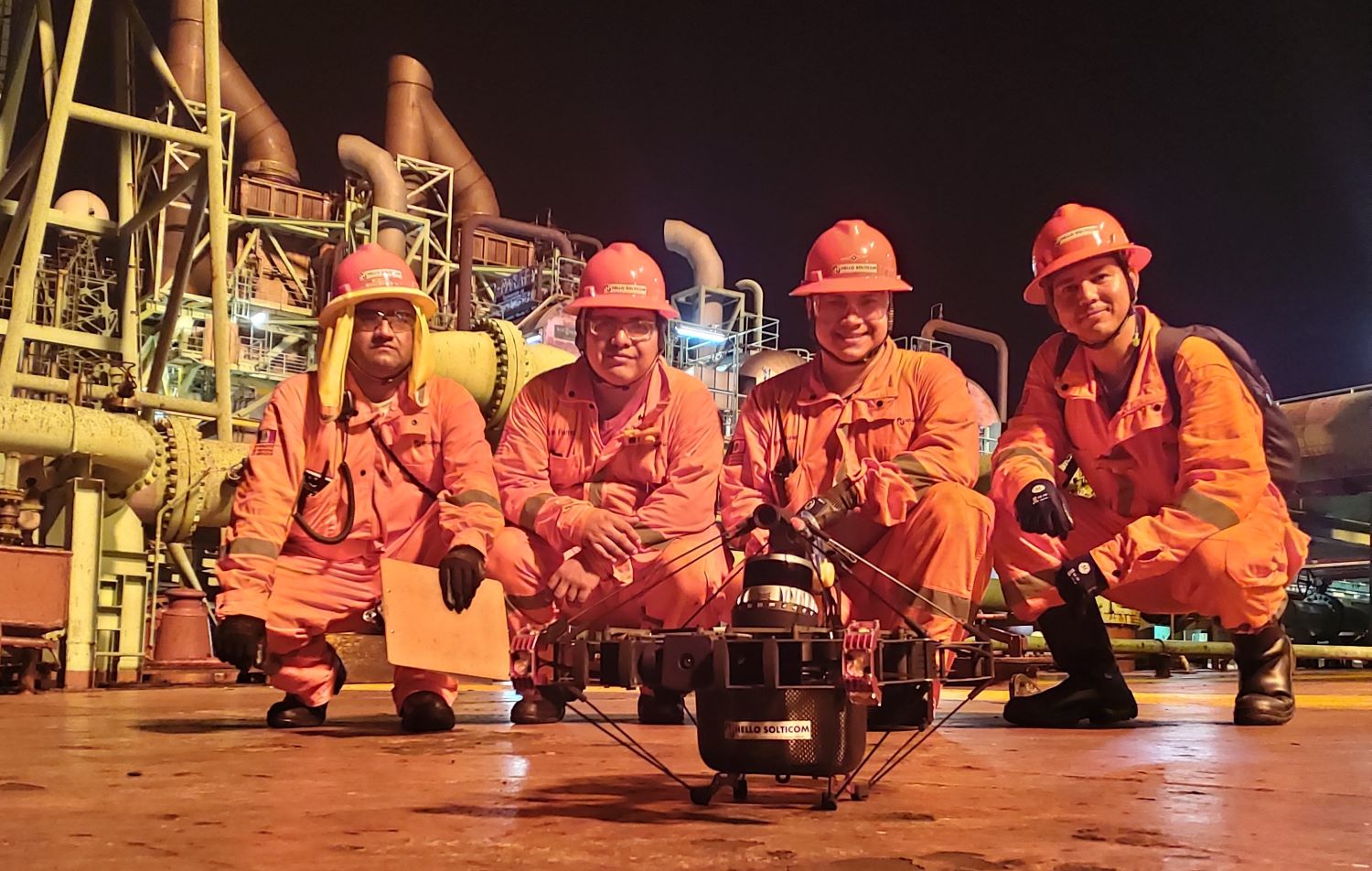
Juan Osorio (Safety Engineer), Jose Fierros (Project Manager), Enrique Montero (Pilot) and Thiago Moura (Pilot).
Extensive hours were invested in a comprehensive pre-operational environmental analysis and meticulous planning by the engineering teams of Hello Solticom and Aerials UAS Solutions. These efforts were key to implementing measures that ensured safer conditions for both personnel and equipment, successfully mitigating potential risks and achieving operational objectives.
Inspection Challenge and Setup
The inspection involved cargo tanks #1 Central, #2 Starboard, and #2 Portside, all part of an FPSO vessel located in the Gulf of Mexico and operated by a Mexican oil company. The environmental conditions presented significant challenges due to the heat radiated by the vessel’s burner near the tanks.
The inspection was executed as a General Visual Inspection (GVI), focusing on specific points in line with Close Visual Inspection (CVI) standards. The flight plans were designed to capture comprehensive data on tank interiors without requiring personnel to enter confined spaces.
Both the takeoff and recovery of the Scout 137 Drone were conducted manually from the deck, complying with RIT (Remote Inspection Techniques) standards and BVLOS (Beyond Visual Line of Sight) criteria. Imagery was captured for the ceiling, lower deck, internal hull sides, and other critical components, including pipes, pumps, suction valves, and structural members.
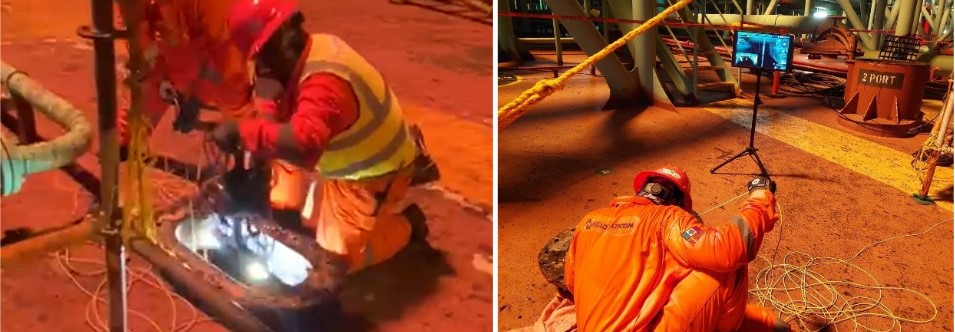
The tethered Scout 137 Drone was hand-launched via a manhole and the team performed the inspection remotely from the Cargo Tank deck. No humans entered the cargo tank.
Key Challenges
There are key challenges that generally complicate this kind of job, particularly when using traditional methods. For example:
- Work at height: Activities conducted at elevated positions, requiring specialized safety measures and equipment. Most often, this is done by rope access but in some cases it may also involve scaffolding, which is particularly expensive, time-consuming and requires skilled labor to erect.
- Residues and presence of explosive/toxic gases: Environmental conditions that create significant safety risks and demand stringent monitoring and mitigation strategies.
- Other time-intensive procedures: Challenges involving logistics, personnel coordination, and controlled entry into hazardous zones.
Previous inspections with conventional battery-operated drones had achieved limited success, failing to meet the client’s quality and precision standards. ScoutDI has proven to be a superior option, with Hello Solticom and Aerials UAS Solutions successfully performing these operations to the highest standards in the Americas.
Goals and Requirements
The primary goals of the inspection were:
- Visualize internal conditions: The tanks’ internal states were partially unknown, and detailed blueprints unavailable.
- Minimize downtime: Complete inspections as efficiently as possible to avoid prolonged operational halts.
- Ensure safety: Reduce personnel exposure to hazardous conditions.
- Deliver actionable insights: Provide point clouds and detailed data for future maintenance planning.
Solution: Scout 137 Drone System
The Scout 137 Drone System was essential for addressing project challenges. Safety was preserved by the overall system design, allowing BVLOS inspection without human entry. The Scout 137 Drone’s Gas Sensor provided additional risk mitigation by offering the capability to detect hazardous gases in real-time, ensuring preparedness for potential risks during confined-space operations.
Efficiency was significantly improved by the unlimited flight-time resulting from the tether system, which provides continuous power to the Drone System and handles all data communication, providing a fully wired connection not vulnerable to radio frequency disturbances or signal loss.
The intuitive interface and ergonomic controls simplified use, reduced setup time, and improved efficiency further.

The Scout 137 Drone’s tether provides continuous power and data communication, allowing unlimited flight time and a fully wired connection.
The Scout Portal
Immediately after the drone was retrieved from the tank, the entire 2-hour inspection flight was uploaded to the Scout Portal via STARLINK.
The Scout Portal is ScoutDI’s cloud-based inspection data service. It has built-in SLAM and enables efficient data processing, visualization and analysis. From there it is easy to share the data with clients and other stakeholders.
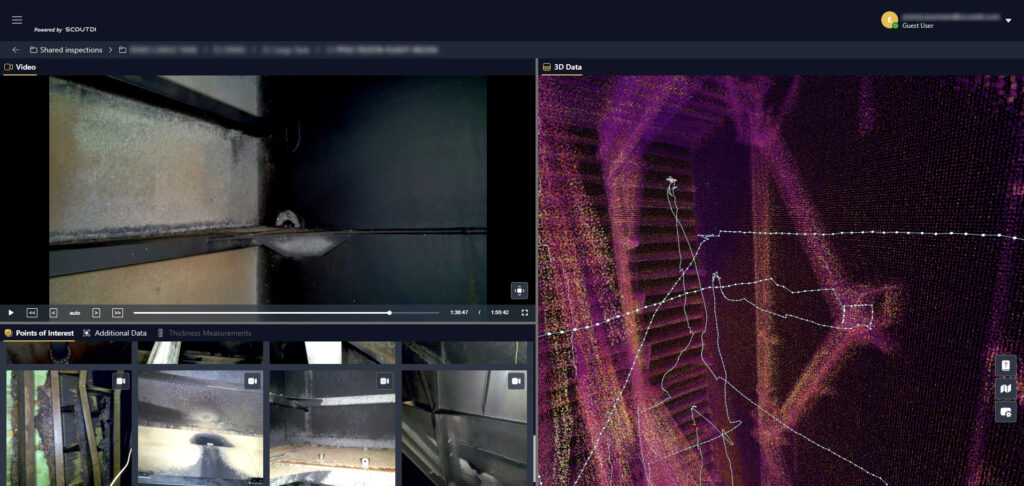
The entire 2-hour flight was immediately uploaded to the Scout Portal via STARLINK. All data from the Scout 137 Drone is location-tagged and visualized in an interactive 3D point cloud.
CAD models and blueprints
As an interesting extra benefit, point cloud downloads from the Scout Portal also allowed the Hello Solticom team to create 3D models and 2D AutoCAD blueprints (BIM) through reverse engineering from point clouds.
This integration of hardware and software provided the client with fast and accurate insights, generating previously non-existent blueprints in significantly less time compared to traditional photographic and manual measurement methods.
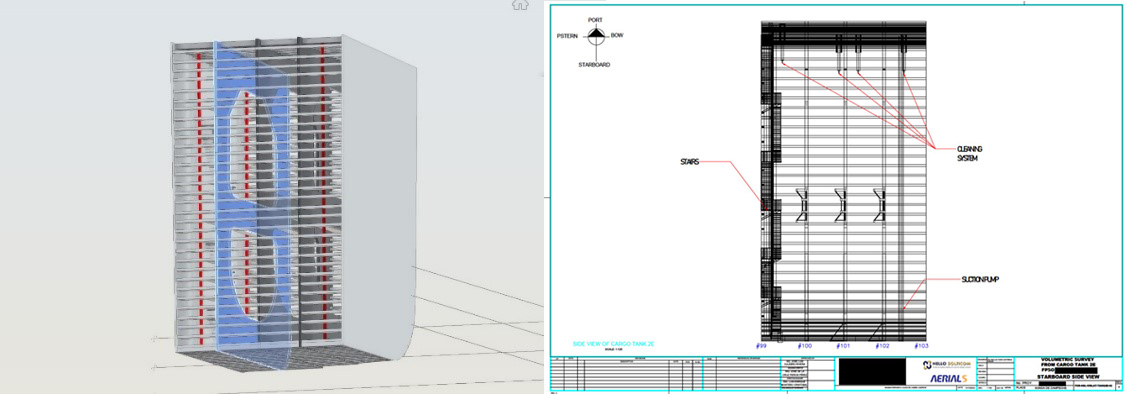
Hello Solticom used Scout Portal PCD (point cloud) files as a basis to create 3D models and 2D CAD blueprints, unlocking new possibilities.
Quantified Results and Cost Savings
Time Saving
Traditional methods for tank inspection would typically take 5-7 days per tank, excluding ventilation and cleaning time. In this case, the tanks were prepared with an ATC (Automated Tank Cleaning) system and ventilated before the drone inspection team arrived.
Using the Scout 137 Drone System, Hello Solticom completed data collection in approximately 2 – 3 hours per tank, plus an additional hour for preparation and demobilization. This represented a dramatic reduction in inspection time and operational downtime.
Safety Improvements
No personnel entered the tanks during the BVLOS operation, reducing exposure to toxic gases and confined space risks. Zero work at height was done.
The operational procedure described here delivers quantifiable safety improvements by effectively removing personnel from the most hazardous aspects of the operation and setting a new standard for safety in confined-space inspection.
Thorough planning ensured safety throughout the process. Constant gas monitoring via the drone’s Gas Sensor provided an extra layer of safety.
Operational Metrics
A single two-hour flight covered the entirety of a cargo tank measuring 33m in depth, 22m in length, and 25m in width—equivalent to a volume of 18,150m3 or 4,200m2 of surface area. The efficiency of the Scout 137 freed up personnel for other critical tasks, optimizing resources.
| Metric | “Manual” inspection | With Scout 137 Drone |
| Visual inspection time | 5-7 days per tank | 2-3 hours per tank * |
| Inspection crew size | At least 6 – 8 people | 2-3 people ** |
*) Inspection time, not including cleaning and ventilation.
**) Some countries require an additional (third) person as a safety engineer.
Unquantified Benefits
Enhanced Operational Efficiency
During operations, a secondary large screen was installed to allow client and class representatives to view the inspection from the pilot’s perspective – and without disturbing the pilot unnecessarily.
This solution allowed the client’s points of interest (POI) to be reviewed more accurately and in real time, facilitating more informed decision-making during the inspection.
The ScoutDI drone also demonstrated its ability to access hard-to-reach areas, particularly in narrow sections of the tank. In these cases, it was necessary to temporarily disable the anti-collision system, allowing precise close-up maneuvering in confined spaces.
Being able to upload data to the Scout Portal over STARLINK is a significant advantage in terms of data backup and the wide accessibility it provides, allowing asset stakeholders to assess data early and provide feedback even while the inspection crew is still present on-site.
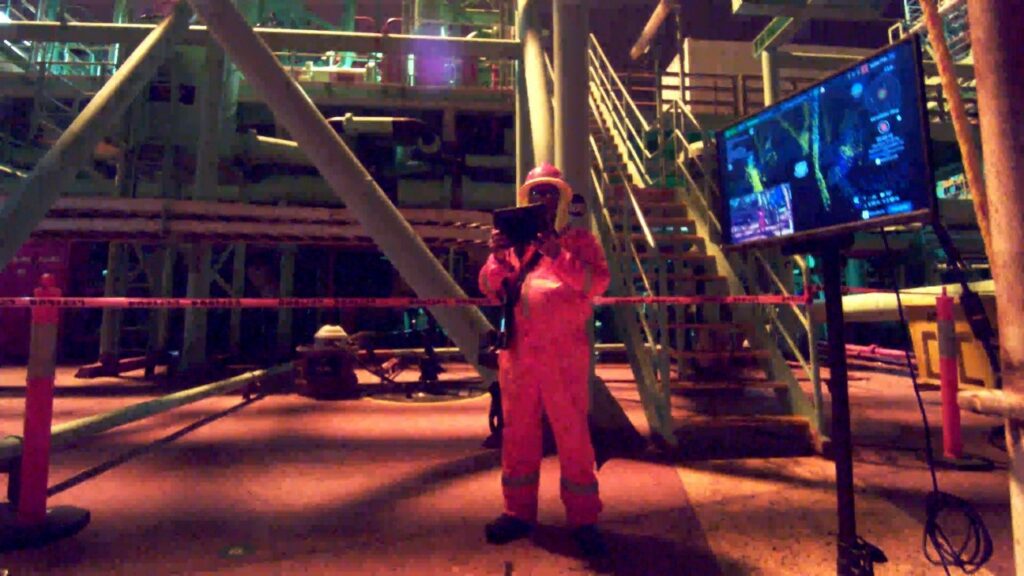
A secondary large screen on deck allowed the client and crew to monitor the inspection live, facilitating more informed decisions in real-time.
Conclusion
Innovative use of the Scout 137 Drone System and Scout Portal revolutionized FPSO tank inspections by delivering unprecedented efficiency, safety, and data quality.
By completing inspections in hours rather than days, the project significantly reduced downtime and provided the client with actionable insights for future maintenance planning.
Campaigns 2 & 3 are scheduled to complete the visual inspection for class requirements and the next step will be UTM inspections.
This successful collaboration between Hello Solticom and Aerials UAS Solutions underscores the transformative potential of advanced drone technology in the Oil & Gas sector. We’re looking forward to the rest of this story. 👍
Hello Solticom – Mexico
Contact: Emmanuel Orozco
Email: emmanuel@hellosolticom.com
Website: www.hellosolticom.com
LinkedIn: https://www.linkedin.com/company/hellosolticom
Aerial UAS Solutions / Aerial Solutions do Brasil
Contact: Dan Pizzato
Email: dapizzato@aerialsuas.com
Website: www.aerialsuas.com
LinkedIn: https://www.linkedin.com/company/aerialuassolutions
Would you like to know more about the Scout 137 Drone System?
Feel free to contact us using the form below! 👍

